Rajasthan Board RBSE Class 11 Biology Chapter 4 Kingdom: Monera, Protista and Fungi
RBSE Class 11 Biology Chapter 4 Multiple Choice Objective Questions
Question 1.
Bacteria were discovered by –
(a) Kotch
(b) Pastcher
(c) Leeuwenhoek
(d) Jenner
Question 2.
Mucopeptide is a symptom of –
(a) Bacteria
(b) Blue – green algae
(c) Green algae
(d) Yeast
Question 3.
Little leaf of brinjal disease is caused by –
(a) Algae
(b) Virus
(c) Mycoplasma
(d) Bacteria
Question 4.
Who is called as “plant clone”
(a) Virus
(b) Bacteria
(c) Fungus
(d) Mycoplasma
Question 5.
Essential for growth of mycoplasma –
(a) Fat
(b) Sterol
(c) Protein
(d) Carbohydrate
Answers:
1. (c)
2. (a)
3. (c)
4. (d)
5. (b)
RBSE Class 11 Biology Chapter 4 Very Short Answer Questions
Question 1.
Who is called as father of bacteriology ?
Answer:
Robert Koch.
Question 2.
Which bacteria inhabit in root nodules of leguminous ?
Answer:
Rhizobium.
Question 3.
What are gram positive bacteria ?
Answer:
Bacteria stained by crystal violet.
Question 4.
What are gram negative bacteria ?
Answer:
Bacteria not stained by crystal violet.
Question 5.
Full form of PPLO?
Answer:
Pleuro Pneumonia Like Organism.
Question 6.
Why mycoplasma is called as pleomorphic ?
Answer:
Absence of cell wall make them pleomorphic.
Question 7.
Write names of two plant disease caused by mycoplasma.
Answer:
Com stunt disease & Cotton stenosus disease.
Question 8.
Give names of two human diseases caused by lm coplasm ?
Answer:
Atypical pneumonia & sterility in man.
Question 9.
Who classified fungi ?
Answer:
Alexopoulas.
Question 10.
Cell wall of fungi are made up of what ?
Answer:
Chitin.
RBSE Class 11 Biology Chapter 4 Short Answer Questions
Question 1.
Give the distribution of bacteria ?
Answer:
Bacteria are cosmopolitan, they are found in land, soil, air water, food, animals, plants etc. Many types of bacteria are found in human intenstine such as Eschrichia coli. They are found in temperature from -190°C to 78°C and some can survive in Ice and boiling water.
They are found in air up to height of many thousand feet and in thc Earth upto adepth of 16 feet, Bacteria are not found in rain water, distilled water, deep well water and volcano ash. They are abundantl found in faeces, milk products. fruits, vegetables etc.
Question 2.
What is capsule ? Explain its role ?
Answer:
Cell wall & capsule – Every bacterium is bounded by a cell wall which is similar to the exoskeleton of in¬sects, In most of the bacteria, a jelly-like extra layer is found outside the cell wall which is called as slime layer. In some bacteria, it is very thick & called as capsule. The slime layer consists of carbohydrates, amino acids & gum.
Question 3.
Differentiate Gram+ & Gram bacteria ?
Answer:
(a) Gram Positive (G+) : These bacteria retain Crystal violet dye, and thus stained violet.
Example – Micrococcus, Streptococus, Leptobacillus, Clostriduim etc.
(b) Gram Negative (G-) : There bacteria do not stain violet after washing with alcohol. When another stain such as safiranin or fuchsine will stain bacteria as pink.
Example – Rhizobuim, Pseudomonas, Salmonella, Vibrio etc.
Question 4.
Draw a labelled diagram of bacterium cell ?
Answer:
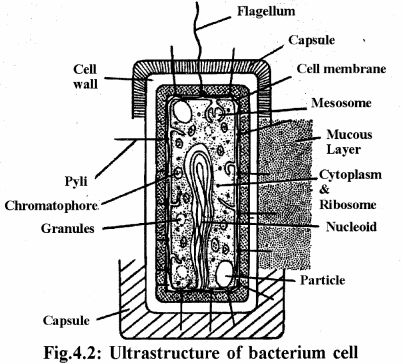
Question 5.
Explain structure of mycoplasma cell ?
Answer:
Mycoplasma is unicellular, microscopic prokaryote which is with our cell wall. It is bounded by a single plasmalemma which is three layered and made up of lipoprotein, phospholipid and cholesterol.its thickness is 80 to 100 Aº. which is without membrane bounded orgenelles but has 70S ribosomes. which includes one nacked & double helical DNA.
In addition, the cytoplasm has RNA, fat, protein, enzymes etc.
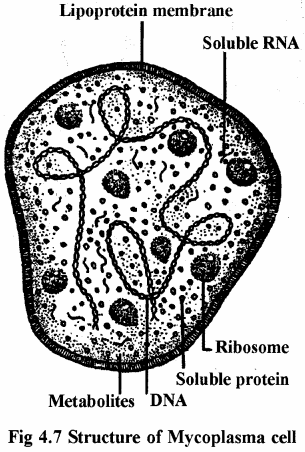
Question 6.
How mycoplasma are transmitted ?
Answer:
Mycoplasm is transmitted in plants through leaf hopper insect. They are also transmitted during plantation. It is transmitted from plant to plant by Amarbel(Mistletoe).
Question 7.
Write common characters of mycoplasma ?
Answer:
- Mycoplasma is without rigid cell wall. hence cancontort into broad range of shapes. from round to
obÍong They are called as clones of animal kingdom. - They are unicellular, non-motile & smallest prokaryotes. They form colony which is like a fried egg.
- They inhabit decaying material, excreta, soil, plants & animals.
- They are parasitic / saprozoic.
- They have both DNA & RNA but DNA is less than RNA.
- They can easily ber cultured on non-cellular culturemedium but stero is are essential for their growth
- Mcopiasma are Gram negative (G-)
- The are not sensor to any enzyme, as they arc with out wall Hence, the remain unaffected by antibiotics
like penicillin, vanconiycin, cephaloridine etc.
Question 8.
Write short note on reproduction in mycoplasma ?
Answer:
mychro plasma reproduce by fission, budding & young elementary bodies. Sexual & asexual reproduction are absent.The reproduction by young elementary bodies is important. In this method, the mycoplasma develops many small & round bodies called elementary bodies. many small & round bodies called elementary bodis. Gradually they develop tu form secondary and tertiary bodies. On maturation, they release from the mother cell & form quaternary bodies which finally form Mycoplasma.
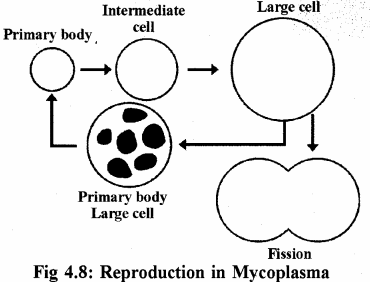
RBSE Class 11 Biology Chapter 4 Essay Type Questions
Question 1.
Give an account of classification of bacteria ?
Answer:
Different morphological characteristics such as size, shape, staining characterstics, flagellation etc are used to clas-sify the eubacteria.
Size – Bacteria are microscopic. Normally their diam-eter varies from 0.2 to 1.5 micron and length varies from 2 to 10 micron and the length of rod-shaped or bacillus bacteria varies from 0.3 to 15 micron. The largest bacterium is Baggiatoa mirabilis. It’s diameter is 16 to 45 micron and length is 80 micron or more.
Shape – On the basis of shape, the bacteria are of following types
1. Coccus or spherical bacteria-They are spherical and their diameter is 0.5 to 1.25 micron.
They are non- flagellated and are of following types
(i) Micrococci – Solitary
Example: Micrococcus agilis, Micrococcus aureus etc.
(ii) Diplococcus – Two or in pair
Example: Diplococcus pneumoniae
(iii) Tetracoccus – Four round cells
Example: Micrococcus tetragcnus Neisseria etc.
(iv) Streptococcus – They are chajn shaped
Example: Sireptococcus lacts
(v) Staphylococcus – Round and forn in grape – like clusters.
Example: Siaphylococcus aurcus
(vi) Sarcinae – Spherical bacteria
Example: Sarcina luteus etc.

2. Bacillus or Rod shaped bacteria
(i) Monobacillus – Single rod-like bacteria.
Example: Bacillum
(ii) Diplobacillus – Two rods arranged side by side with each other.
Example: Coryne bacterium diptherae
(iii) Streptobacillus – Rods arranged in chains.
Example: Bacillum iuberculosis
3. Spiral or cuboidal bacteria
They are spiral or helical shaped and flagellated.
Example: Spirillum minus, spirillum volutans.
4.Vibrio or coma
They arc curved-rod shape or comma shape and monoflagcllated.
Example: vibrio cholerae
5.Filanientous bacteria – They arc very long thin filament-shaped. Some of them form branching filaments
ExampIe: Beggiatoa. Cladothrix, Leptothrix etc.
6.Pleoniorphic bacteria – They are able to alter theirshape or size in response to enironrnental conditions.Hence. they are found m more than one form.
For example: Acetobactor. Minute or long rod(Bascillus) or chain of minute rods (Streptobacillus)
Question 2.
Write an essay on structure & nutrition of bacteria ?
Answer:
Structure of Bacterium cell :
Structure of bacterium cell is simple & primitive. They are different & undeveloped structures than plant cells. Following structures are found under electron mocroscope-
(a) Cell wall & capsule – Every bacterium is bounded by a cell wall which is similar to the exoskeleton of insects, In most of the bacteria, a jelly like extra layer is found outside the cell wall which is called as slime layer. In some bacteria, it is very thick & called as capsule. The slime layer consists of carbohydrates, amino acids & gum. The cell wall of bacteria is made up of peptidoglycane like muramic acid and diaminopimelic acid.
(b) Cytoplasm – It is bounded by a cell membrane. The cytoplasm is homogenous which contain fat gobules & glycogen particles. It is without definite nucleus but nuclear suvstance (DNA) is suspended in the cytoplasm. Such nucleus is called as incipient nucleus. The cytoplasm bears gas vacuoles & ribosomes but membrane bounded orgenelles such as plastids, mitochondria etc are absent.
Some species of bacteria bear a special chlorophyll called bacteria-chlorophyll, hence they perform photosynthesis. The inpushing of the cell membrance are called as Mesosomes which contain respiratory enzymes.

(C) Flagella – Bacteria may be flagellated or non-flagellated. The flagellated bacteria are motile. The number & position of flagella in motile bacteria is variable and on this basis, the motile bacteria are of five types viz-
- Atrichous: They are without flagella.
Example – Micrococcus - Monotrichous: One flagellum at one end.
Example – Vibrio - Lophotrichous – More than one flagella at one end.
Example – Thiospiriluim - Amphitrichous – One or more flagella at both the ends.
Example – Nitrosomonas, spiriluim etc - Peritrichous – Flagella on all over the sides of bac-teria.
Example – Bacillus typhus
nutrition:
On the basis of nutrition bacteria are of two types-
1. Autotrophic bacteria – A few species of bacteria are autotrophs. Some are chemosynthetie and some are photosynthetic like plants.
(a) Photosynthetic bacteria – Some species have bacte- ribchlorophyll or chlorobium chlorophyll pigments which are a compound of magnesium and are found in chromotophores not in plastids. They do not synthesize carbohydrates using CO2& H2O like plants but they perform photosynthesis using CO2 + H2S & product is sulphur instead to O2
CO2 + 2H2S \(\underrightarrow { Light }\) (CH2O)n+ 2S + H2O
Examples: Chromatum, Chlorobuim, chlorobacterium etc.
(b) Chemosynthetie bacteria – Some bacteria convert CO2 into carbohydrates using various types of chemical re-actions. They are without chlorophyll, hence sun light is not required. They perform oxidation of some sub-stances to get energy such as Sulphur & its compound, Ammonia, Nitrates, Iron, Hydrogen, CO, Methane etc. Such as Sulphur bacteria, Iron bacteria etc.
(i) Sulphur bacteria – The obtain energy by oxida¬tion of sulphur & its compounds.
Examples: Beggiatoa, Thiothrix, Thobacillus etc.
2H2S +O2 → 2S + H2O + 122.2 kcal
2S + 2H2O+ 3O2 → 2H2SO4+ 284.4 kcal
(ii) Iron bacteria – They obtain energy by oxidizing ferrous compounds into ferric compounds.
Examples: Gallionella, Leptothrix, Fembacillus etc.
4 FeCO3 + O2 + 6 H2O→ 4 FeCOH3 + 4 CO2
(iii) Hydrogen bacteria – They convert molecular hydrogen into water to get energy.
Example: Bacillus pentatrofera
2H2 + O2 → 2H2 O + 137 kcal energy
2H2+ CO2 → 115 kcal → C6 H12 O6 + H2O
(iv) Nitrifying bacteria – They obtain energy from nitrogen compounds such as-
- Oxidizing ammonia into nitrates
Example: Nitrosomonas, Nitrosococcus etc.
2NH3 + 3O → 2HNO2 + 2H2O + 158 kcal. - Coverting nitrites into nitrates
Example: Nitrobacter, Bactoderma etc.
2 HNO2 + O2 → 2HNO3 + 38 kcal energy.
(v) Carbon bacteria – Some bacteria obtain energy by oxidizing carbon-mono-oxide.
Example – Oligacarbophil etc.
2CO + O2 → 2CO2 + energy.
(vi) Methane bacteria – They obtain energy by oxidizing methane.
Example – Methanomonas etc.
CH4 + 2O → CO2 + 2H2O + energy.
2. Heterotrophic bacteria-
Most of the bacteria are parasitic. They absorb complex organic compounds by making them soluble with the help of enzymes. They are of three types-
(a) Saprophytes – They lead their life on dead complex organic compounds.
Example – Bacillus
(b) Symbionts – They establish permanant relationship with other plants or animals and are mutually benefited.
Example – Rhizobuim bacteria in the nodules of roots of legume plants.
(c) Parasites – They are pathogens and live inside / outside the body of host plant / animal.
Example – Corynibacterium, Xanthomonas.
Question 3.
Explain asexual reproduction in bacteria ?
Answer:
1. Asexual Reproduction – It takes place with the help of non-motile spores which are of two types –
(a) Conidia – They are round / rod-like and borne on the erect & aerial hyphae called conideophores or sporophores which may be branched or unbranched & rise above the colony.
Example – Streptomyces.
(b) Endospore – They are formed during unfavourable conditions. The cell protoplasm constricts in the center due to loss of water and soon a thick wall develops around it. This structure is called as endospore. The endospores are able to resist unfavourable conditions.
Example – Bacillus.
2. Sexual Reproduction – It is not a common rpeofreproduction in bacteria. they exhibit following 5 steps of symbolic sexual reproduction which is also called as gene recombination.
(a). Conjugation – This method of reproduction in bacteria was discovered b Lederberg and Taturn (1946) in Escherichicoil bactcria Iatar on. it was discoverd in In this process.
one donor (male) bacterium make phsical contact with the help of pulus or conjugationtube to another recipient (female) bacteruim to transfer the genetic material Male is denoted by F+ and femalebacterium b F. F+ variant (conjugant) has more powerof mating. hence the are also called as high frequeiice(Hfr) variants (coajugants).
The genetic material of male conjugant (F+) istransferred into the female conjugint (F) In female (F)bacterium, the genetic material get attached to aindependent F-factor (episome) as a result, the femaleconjugant becomes 11fr bacterium. It is different fromboth donor & recipient bacteria. Consugation is aprimitive type of sexual reproduction in which cellnumber remain unchanged.

(b) Transformation – It was discovered by Fedrick Griffith (1928) in Diplococcus pneumonae bacteria.The exogenous DNA is taken up into the recipientbacterium from its surroundings through the cellmembrane. It result in the genetic alteration of the recipient cell.
(c) Transduction – It is an important method of genetransfer in some bacteria which involves bacteriophageas vector, it was discovered by Zinder and Lederberg(1952) in Salmonella bacteria.It does not require any physical contact between the donor & recipient. The bacteriophage infects the bacteria to transfer DNA and lateron multiply to
increase number inside the bacterium.
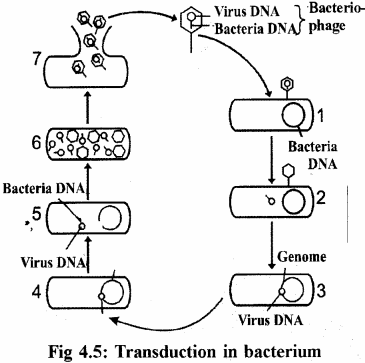
Question 4.
Describe gene recombination techniques in bacteria. Give diagrams ?
Answer:
Transduction – It is an important method of gene transfer in some bacteria which involves bacteriophage as vector. It was discovered by Zinder and Lederberg (1952) in Salmonella bacteria.It does not require any physical contact between the donor & recipient. The bacteriophage infects the bacteria to transfer DNA and lateron multiply to increase number insude the bectrium

Question 5.
Describe structure & reproduction in mycoplasma ?
Answer:
Structure of Mycoplasma:
Mycoplasma is unicellular, microscopic prokaryote which is withour cell wall. It is bounded by a single plasmalemma which is three layered and made up of lipoprotein, phospholipid and cholesterol. The plasmalemma is selectuely permeable and its thickness is 80 to 100 A0. The plasmalemma encloses cytoplasm which is without membrane bounded orgenelles but has 70S ribosomes. The cytoplasm has nucleoid which includes one nacked & double helical DNA. In addition,
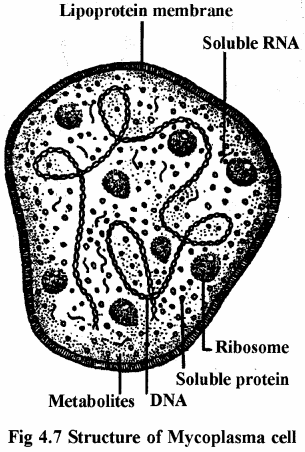
reproduction of Mycoplasma:
mycro plasma reprodce by fission, budding & young elementary bodies. Sexual & asexual reproduction are absent.
The reproduction by young elementary bodies is important. In this method, the mycoplasma develops many small & round bodies called elementary bodies. Gradually they develop to form secondary and tertiary bodies. On maturation, they release from the mother cell & form quaternary bodies which finally form Mycoplasma.
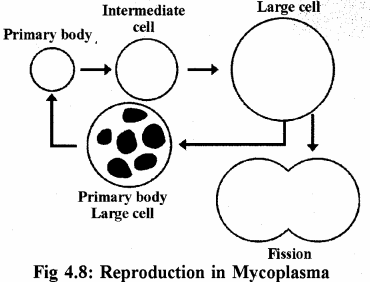
Mycoplarm is transmitted in plants through leaf hopper insect. They are also transmitted during plantation. It is transmitted from plant to plant by Amarbel (Mistletoe)
Question 6.
Explain nature & features of mycoplasma ?
Answer:
Salient features of Mycoplasma
- Mycoplasma is without rigid cell wall, hence can contort into broad range of shapes, from round to oblong.
They are called as clones of animal kingdom - They are unicellular, non-motile & smallest prokaryotes. They form colony which is like a fried egg
- They inhabit decaying material, excreta, soil, plants & animals.
- They are parasitic / saprozoic.
- They have both DNA & RNA but DNA is less than RNA.
- They can easily ber cultured on non-cellular culture medium but sterols are essential for their growth
- Mycoplasma are Gram negative (G“)
- They are not sensory to any enzyme, as they are without cell wall. Hence, they remain unaffected by antibiotics like penicillin, vancomycin, cephaloridine etc
Question 7.
Write an essay on diseases caused by mycoplasma ?
Answer:
Diseases caused by mycoplasma
(A) Plant diseases:
- Grassy shoot of Sugarcane
- Little leaf of Brinjal
- Bunchy top disease of Papaya
- Cotton stenosis disease
- Com stunt disease
- Kurchisum disease of Potato ( Potato purple top disease)
(B) Human diseases:
- Atypical pneumonia
- Respiratory tract infection
- Sterility in man
- Inflammatory disease of genitals Animal diseases
(C) animals diseases:
- Cattle oedema disease
- Contigeous caprine pleuropneumonia disease.
- Phlebitis disease of Hens.
Question 8.
Give the classification of fungi given by Alexopoulas?
Answer:
Classification of Fungi:
Many classification have been propounded by different scientists from time to time.In this chapter, the classification given by Alexopoulus is followed. C.J. Alexopoulas (1962 and 1968) placed all the fungi under division-Mycota. The salient features of mycota are minute thallus, unicellular or filamentous, nucleus with distinct nuclear membrane, chitinous cell wall, reproduction both asexual and sexual etc. Division – mycota is divided into 2 subdivision viz – My ⇒ xomycetes & Eumycotina.
(A) Subdivision – Myxomycotina : Plant body is in the form of nacked protoplasm called plasmodium. 1 class ⇒ Myxomycetes – Vegetative phase is Plasmodium. Reproduction takes place by very small multi nucleated spores.
Example – Physarum
(B) Subdivision – Eumycotina : Vegetative phase is either unicellular or branched mycelium with distinct cell wall. Hyphae are coenocytic or septate. Each cell may be uni, bi or multinucleated.
Reproduction by spores (asexual) and gametes (sexual) It has been divided into eight natural classes and one
form-class –
1. Class – Chytridiomycetes.
Motile cells with single whiplash flagellum placed posteriorly.
Example – Synchytrium.
2. Class – Hypochytridiomycetes.
It includes aquatic fungi. Motile cells with single tinsel flagellum placed anteriorly.
Example – Rhizidiomyces.
3. Class – Oomycetes.
It includes parasitic & saprophytic fungi. Vegetative phase consists of multinucleated and well developed mycelium. Motile cell have two flagella ie. biflagelate consists of one Whiplash & the other Tinsel type.
Example – Albugo.
4. Class – Plasmodiophoromycetes.
It includes parasitic fungi. Multinucleate thallus without cell wall. Motile cells are with two whiplasm flagella of unequal length.
Example – Plasmodiophora.
5. Class – Zygomycetes.
Well developed coenocytic mycelium grows either parasitically or saprophytically. Motile cells are absent.
Example – Mucor.
6. Class – Trichomycetes.
Multinucleated simple or branched thallus. Mostly parasitic on Arthopods.
Example – Harpella.
7. Class – Ascomycetes.
Well developed mycelium with septate hyphae. Ascospores are produced endogenously inside ascus.
Example – Neurospora.
8. Class – Basidiomycetes.
Well developed mycelium with septate hyphae. Basidiospores are produced exogenously on basidium.
Example – Puccinia, Agericus.
Form – class – Deuteromycetes: Well developed mycelium with septate hyphae sexual phase unknown. Reproduces mainly by asexual means.
Example – Alternaria.
Question 9.
Give an account of beneficial & harmful fungi with Examples?
Answer:
importance of Fungi increased with the developement of human culture.
(A) Beneficial Fungi:
(i) Fungi as Food – They are rich sources of proteins, carbohydrates & salts, hence many of them are used as food. Such as Morchella esculenta, Agericus bispora. Agericus campestris etc. Yeast is a supplementary food for human beings & cattles.
(ii) Industrial use – Many fungi are used to obtain enzymes, carbonic acid and alcohol. For example Citromyces pfefferianus, Penicillium oxalicum and Asperigillus oryzae are used to get citric acid, oxalic acid & lactic acid respectively. Similarly, alcohol is obtained by fermentation of sugar performed by Saccharomyces cerevisiae. Vitamin D and vitamin B complex are obtained by the action of Penicillium, Aspergillus and Yeast.
(iii) Medicinal uses – Many fungi are used to obtain antibiotics, such as penicillin is obtain from Penicillium notatum, anti amoebin from Emericellopsis punensis and SQ30, 957 from Penicillium funiculosium. Alkaloids used in various diseases such as argotamin, Argotoxin etc are obtained from fungus Claviceps purpurea. The steroids obtained from Mucor griseo- cyanus & Rhizopus stolonifer are used to treat arthritis, allergy etc.
(iv) Plant hormones – Popular gibberellin growth hormone is obtained from Gibberella Jujikuroi and Fusarium Moniliforme fungi.
(B) Harmful Fungi:
Many species of fungi are harmful and caure diseases in man and plants.
1. Plant diseases – Plant diseases caused by fungi are very common. Such is White Rust disease of mustard is caused by Albugo Candida; Green ear disease of millet caused by Sclerospora graminicola; Rust diseases of wheat by various species of Puccinia; Tikka disease of groundnut caused by Cercospora per sonata etc.
2. Fungal diseases of man & cattles – The fungal diseases caused in man & cattle are called as mycosis. Such as Aspergillus funigatus infects lungs; Trichophyton causes ring worm disease etc.Candiasis is infection of skin, mouth, respiratory tract is caused by Candida albicans.
3. Spoilage of food products – Many fungi such as Mucor, Neurospora spoil food products like milk, curd, cheese, meat, fish, bread, fruits, vegetables, pulses etc.
4. Some fungi are highly poisnous and their intake is lethal. Some poisnous mushrooms are Amanita, Russula, Boletus etc.
Question 10.
Write in brief on lichens?
Answer:
Lichens are composite organism (symbionts) of algae & fungi. Their alga & fungus components are respectively called as Phycobiont and Mycobiont. The phycobionts belong to cyanophyceae & chlorophyceae and mycobionts belong to Ascomycetes and Basidiomycetes. Lichens in India are found in Himalaya regions, moist shady regions, on the bark of trees and on the rocks with bryophyte plants.The vegetative part of Lichen is thallus.
The thallus is flat, leaf like and lobed. It resembles the dried liverworts of bryophate. The thallus has distinct dorsal and ventral surfaces. The dorsal surface is dark brown or light green whereas the ventral side is black in colour. The thallus is attached to the substratum! with the help of ventral rootlets called rhizines. The rhizines are single, branched or unbranched hyphae.The internal structure of the thallus is complex.
Internally, it has apper cortex, algae layer, medulla and lower cortex.Nutrition to lichen is provided by alga. The alga synthesize sugar by photosynthesis. This sugar is used by fungus. Hence, there is symbiotic nutrition. Vegetative reproduction in lichen takes place by fission & special structures called soredia & insidia.Sexual reproduction in lichen depends on fungus. If the associated fungus is member of Ascomycetes, the sexual reproduction is by ascospores.
The ascospores are formed in asci (singular – ascus) which are confined in funnel body called Apothecium Male reproductive organs are called sporogonium and female reproductive organs are called as carpogonium.
Types of Lichens:
They are of three types on the basis of shape & structure viz.
1.Crustose Linchens – Their thallus is flat and they grow lightly appressed to a substrate forming a biological layer of the adhering organism. They adhere very closely to the substratum at all points with the help of rhizines. The shape of the thallus may be round or oval or branched. The colour of the thallus is brown or red or yellow or black etc.
2.Foliose Lichens – These lichens are flat & lobed like leaf. The thallus is attached to the substratum with the help of rhizines which may be branched or unbranched. Some leafy lichens are attached with the help of hapteron. In some lichens, the rhizines have disc- like ends which secrete mucilase that help in attachement.
Example – Gyrophare, Parmelia, Collema etc
3.Fructose Lichens – The Thallus of these lichens is highly branched & they are bush-like. They are Cylendrical or ribbon-like and branched.
The branches are hairy or leafy. Upper & lower surface are not distinct in the Thallus. The Thallus is attached to the substratum with the help of Flate disc. The Thallus is brownish green, yellowish green, Bluish-green or black.
Example – Usnea, Cladonia etc.
A. Useful Lichens:
- Lichens develop as pioneer vegetation & begin the process of succession.
- Lichens are highly sensitive to pollution & have zero tolerance to SO2 pollution. Hence, they are indicator of pollution.
- Some Liches are used as food for insects & catterpilar larvae.
- Liches are also used for treatment of various diseases. Such as Peltigera canina Lichen is used to treat hydrophobia. Parmelia saxatilis is also called as skull lichen and it is used to treat epilepsy.
- Thallus of lichen release special aroma (fragrance), hence is used in dhup batti (incense) & havan (Ritual).
- Some dried lichens are also used as spice.
- Lichen rock is popular as “Pathar ke bhool”.
B. Harmful Lichens:
- During summer the dried lichens become inflammable.
- They catch fire & result in forest fire.
- Some lichens are highly toxic & may be lethal.
- In humid & moist places, the lichens grow on the doors, windows, walls, floor etc & damage the building.